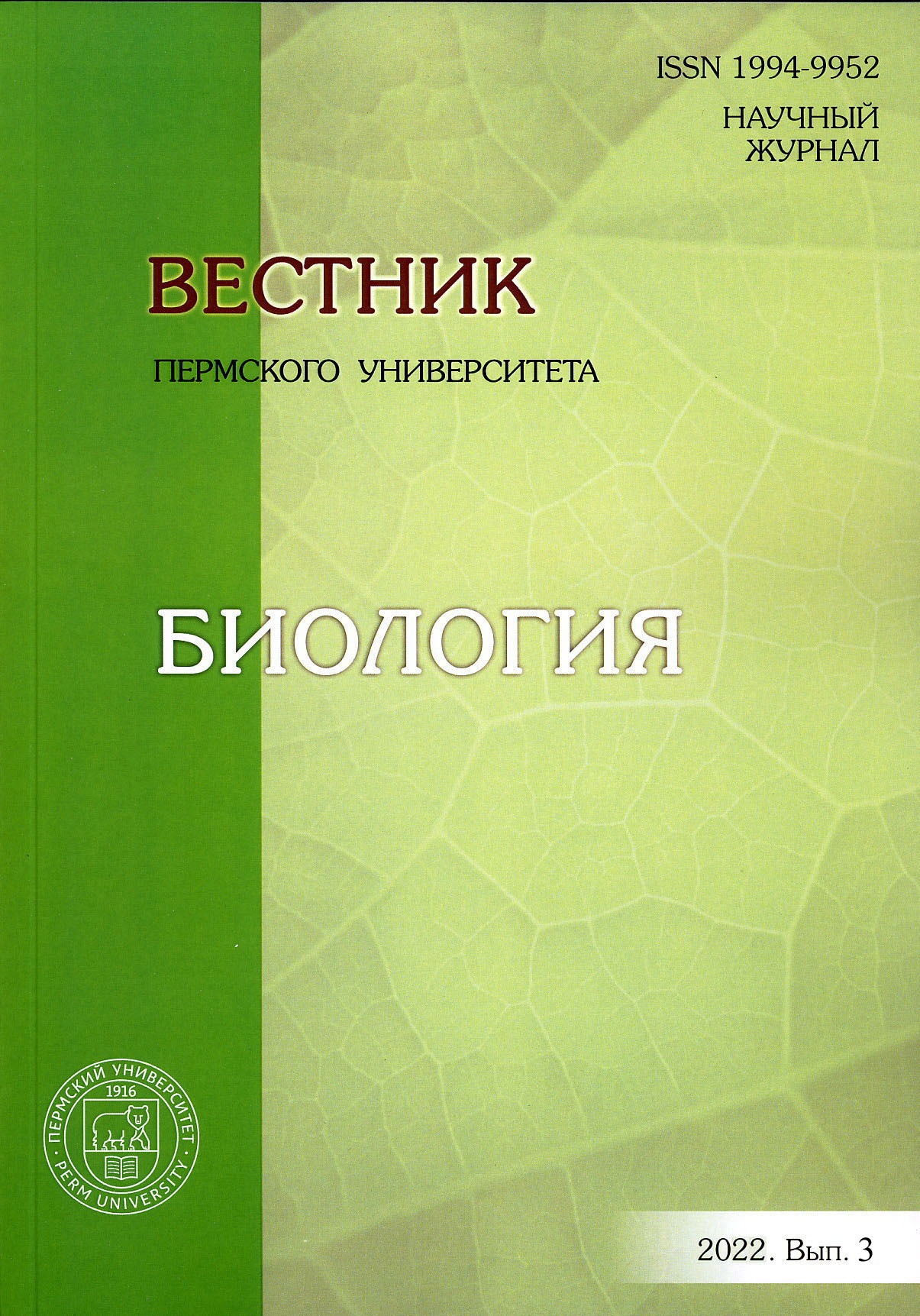The genus Dryopteris Adans. in the European Russia
Main Article Content
Abstract
Article Details
References
Данилов М.П. Dryopteris Adans. – Щитовник // Флора Сибири. Lycopodiaceae – Hydrocharitaceae. Новосибирск: Наука, 1988. С. 60–62.
Конспект флоры Восточной Европы. / под ред. Н.Н. Цвелева. М.; СПб.: Т-во науч. изд. КМК, 2012. Т. 1. 630 с.
Малых С.Ю. Виды, слагающие Dryopteris dilatata комплекс, в Пермском крае // Вестник Пермского университета. Сер. Биология. 2017. Вып. 4. С. 380–389.
Малых С.Ю. О возможности и целесообразности создания системы отдельного рода с привлечени-ем большого числа таксономических признаков // Исследования в области ботаники, генетики и миколо-гии: материалы Всерос. науч. конф., посвященной 105-летию кафедры ботаники и генетики растений ПГНИУ и памяти заслуженных профессоров ПГНИУ В. А. Верещагиной и Е. И. Демьяновой. Пермь, 2022. С. 24‒29.
Науялис И.И., Филин В.Р. Щитовник мужской // Биологическая флора Московской области. М.: Изд-во Моск. ун-та, 1983. Вып. 7. С. 3–25.
Фомин А.В. Род Щитовник – Dryopteris Adans. // Флора СССР. Л.: Изд-во АН СССР, 1934. Т. 1. С. 30–44.
Цвелев Н.Н. О роде Dryopteris Adans. (Dryopteridaceae) в Восточной Европе // Новости систематики высших растений. 2003. Т. 35. С. 7–20.
Шмаков А.И. Определитель папоротников России. 2-е изд., перераб. и допол. Барнаул: ARTИКА, 2009. 126 с.
Benl G. & Eschelmüller A. Über „Dryopteris remota“ und ihre Vorkommen in Bayern // Ber. Bayer. Bot. Ges. 1973. Vol. 44. P. 101–141.
Braun A. Betrachtungen über die Erscheinung der Verjüngung in der Natur, ins- besondere in der Lebens- und Bildungsgeschichte der Pflanzen. Leipzig: Verlag von Wilhelm Engelmann, 1851. 363 p.
Bujnoch W. A contribution to the plylogeny of Dryopteris remota by genotyping of a fragment of the nuclear PgiC gene // Fern. Gaz. 2015. Vol. 20(2). P. 79–89.
Crabbe J.A., Jermy A.C., Walker S. Distribution of Dryopteris assimilis S. Walker in Britain // Watsonia. 1970. Vol. 8. P. 3–15.
Döll J.Ch. Rheinische Flora. Brönner, Frankfurt a. M., 1843. 832 p.
Döpp W. Die Apogamie bei Aspidium remotum Al. Br. // Planta. 1932. Vol. 17. P. 86–152.
Döpp W. Weitere Untersuchungen an apogamen Farnen // Ber. Dtsch. Bot. Ges. 1933. Vol. 51. P. 341–347.
Döpp W. Versuche zur Herstellung von Artbastarden bei Farnen, I // Ber. Dtsch. Bot. Ges. 1935. Vol. 53. P. 630–636.
Döpp W. Cytologische und genetische Untersuchungen innerhalb der Gattung Dryopteris // Planta. 1939. Vol. 29. P. 481–533.
Döpp W. Experimentell erzeugte Bastarde zwischen Dryopteris filix-mas (L.) und D. paleacea (Sw.) C. Chr. // Planta. 1955. Vol. 46. P. 70–91.
Fraser-Jenkins C.R. Dryopteris caucasica, and the cytology of its hybrids // Fern. Gaz. 1976. Vol. 11(4). P. 263–267.
Fraser-Jenkins C.R. A classification of the genus Dryopteris (Pteridophyta: Dryopteridaceae) // Bull. Br. Mus. nat. Hist. (Bot). 1986. Vol. 14, № 3. P. 183–218.
Fraser-Jenkins C.R. Dryopteris Adans. // Flora Europaea, 2nd ed. Gateshead: Cambridge University Press, 1993. Vol. 1. P. 27–30.
Fraser-Jenkins C.R. The species and subspecies in the Dryopteris affinis group // Fern Gaz. 2007. Vol. 18(1). P. 1–26.
Freigang J., Bujnoch W., Zenner G. Erstfunde von Dryopteris ×brathaica Fraser-Jenk. & Reichst. (Dryop-teridaceae, Pteridophyta) in Süd-Deutschland – morphologische und molekulargenetische Untersuchungen // Kochia. 2013. Vol. 7. P. 67–86.
Hornych O. Reproduction and hybridization in ferns. Ph.D. Thesis Series 2020, No. 22. University of South Bohemia, Faculty of Science, School of Doctoral Studies in Biological Sciences, České Budějovice, Czech Republic, 2020. 162 p.
Krause S., Hachtel M., Bennert H.W. Dryopteris × brathaica Fraser-Jenk. & Reichst. (Englischer Wurm-farn; Drypoteridaceae, Pteridophyta) in Deutschland // Feddes Repert. 2001. Vol. 112. P. 247–260.
Manton I. Problems of Cytology and Evolution in the Pteridophyta. Cambridge: Cambridge University Press, 1950. 316 p.
Rünk K., Zobel M., Zobel K. Biological Flora of the British Isles: Dryopteris carthusiana, D. dilatata and D. expansa // Journ. of ecology. 2012. Vol. 100. P. 1039–1063.
Stace C.A. Dryopteris Adans. – Buckler-ferns // New flora of the British Isles. 3rd ed. Cambridge: Cam-bridge University Press, 2010. P. 33–38.
Sessa E.B., Zimmer E.A. & Givnish T.J. Unraveling reticulate evolution in North American Dryopteris (Dryopteridaceae) // BMC Evol. Biol. 2012. Vol. 12. P. 104–127.
Trewman K., Pigott A. Some taxa within the 'Dryopteris affinis' complex: a field guide. London: British Pteridological Society, 2014. 48 p.
Widén C.J., Sarvela J., Ahti T. The Dryopteris spinulosa complex in Finland // Act. Bot. Fenn. 1967. Vol. 77. P. 1–24.
Widén C.J. et al. Die Phloroglucide von Dryopteris villarii (Bell.) Woynar und anderer Farne der Gattung Dryopteris sowie die mögliche Abstammung von D. filix-mas (L.) Schott. Helvetica Chimica Acta. 1971. Vol. 54. P. 2824–2850.
Widén C.J. et al. Die Phloroglucide von zwei Farnhybriden aus England und Schottland, von authenti-schem “Aspidium remotum” A. Braun und von Dryopteris aemula (Aiton) O. Kuntze aus Irland // Helv. Chim. Acta. 1976. Vol. 59. P. 1725–1744.
